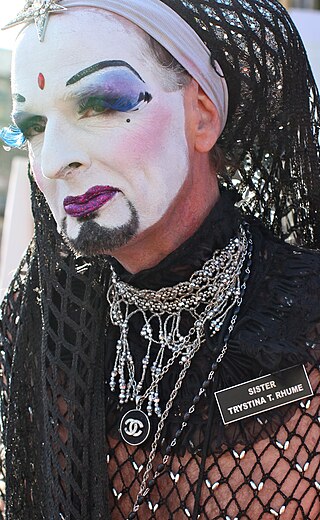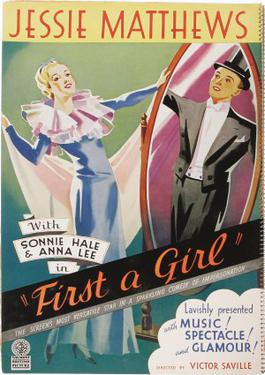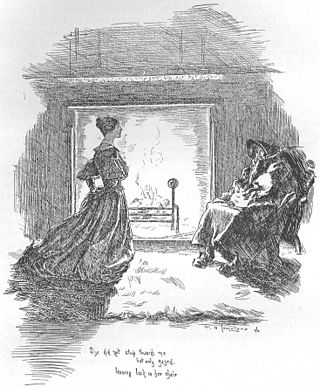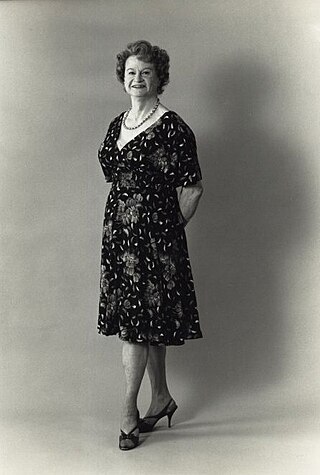
Cross-dressing is the act of wearing clothes traditionally or stereotypically associated with a different gender. From as early as pre-modern history, cross-dressing has been practiced in order to disguise, comfort, entertain, and express oneself.

Glen or Glenda is a 1953 American independent exploitation film directed, written by and starring Ed Wood, and featuring Wood's then-girlfriend Dolores Fuller and Bela Lugosi. It was produced by George Weiss who also made the exploitation film Test Tube Babies that same year.

Charles Pierce was one of the 20th century's foremost female impersonators, particularly noted for his impersonation of Bette Davis.

Drag kings have historically been mostly female performance artists who dress in masculine drag and personify male gender stereotypes as part of an individual or group routine. As documented in the 2003 Journal of Homosexuality, in more recent years the world of drag kings has broadened to include performers of all gender expressions. A typical drag show may incorporate dancing, acting, stand-up comedy and singing, either live or lip-synching to pre-recorded tracks. Drag kings often perform as exaggeratedly macho male characters, portray characters such as construction workers and rappers, or impersonate male celebrities like Elvis Presley, Michael Jackson and Tim McGraw. Drag kings may also perform as personas that do not clearly align with the gender binary. Drag personas that combine both stereotypically masculine and feminine traits are common in modern drag king shows.
Transvestism is the practice of dressing in a manner traditionally or stereotypically associated with a different gender.
Gender expression, or gender presentation, is a person's behavior, mannerisms, and appearance that are socially associated with gender, namely femininity or masculinity. Gender expression can also be defined as the external manifestation of one's gender identity through behavior, clothing, hairstyles, voice, or body characteristics. Typically, a person's gender expression is thought of in terms of masculinity and femininity, but an individual's gender expression may incorporate both feminine and masculine traits, or neither. A person's gender expression may or may not match their assigned sex at birth. This includes gender roles, and accordingly relies on cultural stereotypes about gender. It is distinct from gender identity.

A gender bender is a person who dresses up and presents themselves in a way that defies societal expectations of their gender, especially as the opposite sex. Bending expected gender roles may also be called a genderfuck.
Tri-Ess is an international educational, social, and support group for heterosexual cross-dressers, their partners, and their families.

Cross-dressing and drag in film and television has followed a long history of cross-dressing and drag on the English stage, and made its appearance in the early days of the silent films. Charlie Chaplin and Stan Laurel brought the tradition from the English music halls when they came to the United States with Fred Karno's comedy troupe in 1910. Both Chaplin and Laurel occasionally dressed as women in their films. Even the beefy American actor Wallace Beery appeared in a series of silent films as a Swedish woman. The Three Stooges, especially Curly, sometimes appeared in drag in their short films. The tradition has continued for many years, usually played for laughs. Only in recent decades have there been dramatic films which included cross-dressing, possibly because of strict censorship of American films until the mid-1960s. One early exception was Alfred Hitchcock's thriller Murder!, where the murderer is a transvestite who wears particularly frilly dresses and petticoats. Cross-gender acting, on the other hand, refers to actors or actresses portraying a character of the opposite gender.
In the context of gender, passing is when a person is perceived as a gender by which they identify or as which they are attempting to be seen. Historically, this was common among women who served in occupations where women were prohibited, such as in combat roles in the military. For transgender people, it is when the person is perceived as cisgender instead of the sex they were assigned at birth. For example, a transgender man is passing if he is perceived as a cisgender man.

Joan of Arc, a French historical figure executed by the English for heresy in 1431, is a national heroine of France and a Roman Catholic saint. Joan accompanied an army during the Hundred Years War, adopting the clothing of a soldier, which ultimately provided a pretense for her conviction and execution. Whether her crossdressing and lifestyle have implications for her sexuality or gender identity is debated.

First a Girl is a 1935 British comedy film directed by Victor Saville and starring Jessie Matthews. First a Girl was adapted from the 1933 German film Viktor und Viktoria written and directed by Reinhold Schünzel. It was remade as the 1982 American musical comedy Victor/Victoria starring Julie Andrews.

A transgender person is someone whose gender identity differs from that typically associated with the sex they were assigned at birth.

Cross-gender acting, also called cross-gender casting or cross-casting, is when actors or actresses portray a character of the opposite sex. It is distinct from both transgender and cross-dressing character roles.

Cross-dressing as a literary motif is well attested in older literature but is becoming increasingly popular in modern literature as well. It is often associated with character nonconformity and sexuality rather than gender identity.

Virginia Charles Prince, born Arnold Lowman, was an American transgender woman and transgender activist. She published Transvestia magazine, and started Full Personality Expression, which later became Tri-Ess, for male heterosexual cross-dressers.
This article details the history of cross-dressing, the act of wearing the clothes of the sex or gender one does not identify with.

Ella Wesner was a celebrated male impersonator of the Gilded Age vaudeville circuit.

Lee Greer Brewster was an American drag queen, transgender activist, and retailer. He was a founding member of the pre-Stonewall activist group, Queens Liberation Front. In the 1970s and 1980s, he published Drag magazine. Brewster helped to raise funds for the very first U.S. celebration of Pride, Christopher Street Liberation Day in 1970. He continued to help raise funds and organize Christopher Street Liberation Day for several years. Lee Brewster was active in the homophile and gay liberation movements, working with the Mattachine Society of New York as well as the Street Transvestite Action Revolutionaries.

Sazanami Cherry is an otokonoko romance manga created by Rika Kamiyoshi. It was originally serialized by Ichijinsha in their magazine Waai! from April 24, 2010, to August 25, 2011, and has since been collected in a single tankōbon volume. Together with Reversible!, it was the first manga published under the Waai! Comics imprint.














